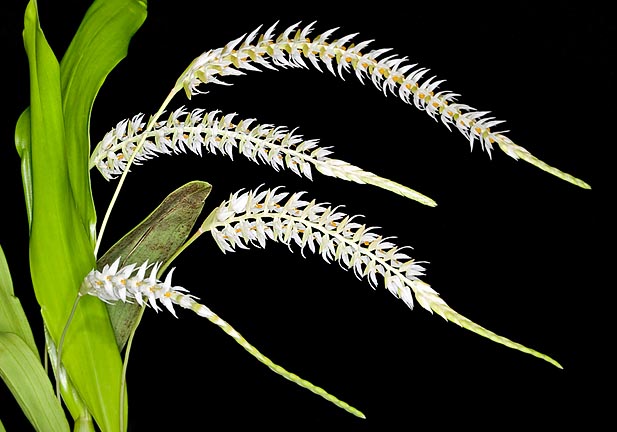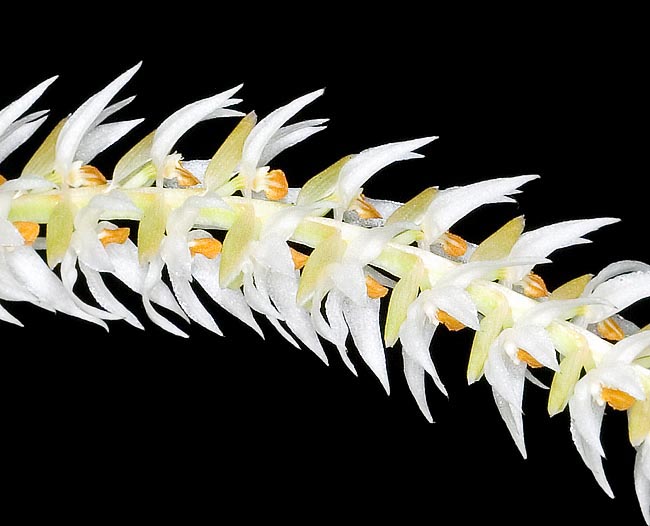Family : Orchidaceae

Text © Pietro Puccio

English translation by Mario Beltramini

Dendrochlum glumaceum is a tropical epiphyte with curved 20-50 cm inflorescences © Giuseppe Mazza
The name of the genus is the combination of the Greek terms “déndron” = tree and “cheilos” = lip, with reference to its epiphytic nature and the prominent labellum; the name of the species is the Latin term “glumaceus” = provided with glume (bract surrounding the spikelet in the inflorescence of the Gramineae).
Common names: hay-scented orchid, husk-like dendrochilum (English).
The Dendrochilum glumaceum Lindl. (1841) is an epiphytic or lithophytic species with tight ovoid pseudobulbs, 1,5-5 cm long and with a diameter of 0,5-1,5 cm, provided with one only oblanceolate or elliptic leaf, 10 to 50 cm long and 2 to 4 cm broad; when left undisturbed it forms big tufts.
The inflorescences, which develop simultaneously with the new pseudobulb and the new leaf, are curved, 20-50 cm long, carrying several tiny alternate flowers, tight, regularly placed on two rows, with ivory white sepals and petals and orange yellow labellum, with, at the base, lanceolate bracts similar to glumes of an usually greenish colour, pink at times, about 8 mm long; the flowers are pleasantly scented.
The sepals are lanceolate, 5-12 mm long and 1-2 mm broad, the petals are oblong, with pointed apex, 4-8 mm long and 1-2 mm broad, the orange yellow labellum, trilobate, is 2-4 mm long and about 2 mm broad. It reproduces by seed, in vitro, and by division.

The tiny flowers are scented, ivory white with orange labellum. They last even a month © Giuseppe Mazza
During the vegetative period, in spring-summer, it requires a partial shade, medium-high temperatures and high atmospheric humidity, 60-80%, with abundant waterings and regular fertilizations.
In winter, the luminosity must be high, also slightly filtered sunlight, the waterings are to be reduced, leaving the compost to partly dry up, and the temperatures are to be kept possibly between the 15 and the 20 °C; a good air circulation is essential in all seasons.
For the waterings and the nebulisations are to be used rain water, water obtained by reverse osmosis or demineralised and the fertilizations, duly distributed in way to avoid salts accumulations, are to be preferably done with hydro soluble balanced products, with microelements, at ¼ of the dosage suggested on the package.
It can be cultivated in pot or basket with draining and aerated compost which may be formed by finely cut bark fragments, charcoal and sphagnum. It does not like to be disturbed, therefore repottings and divisions are to be done only when strictly necessary, at the time of the vegetative restart.
The species is inscribed into the appendix II of the CITES (species whose trade is internationally ruled).
Synonyms: Platyclinis glumacea (Lindl.) Benth. ex Hemsl. (1881); Acoridium glumaceum (Lindl.) Rolfe (1904).
→ For general notions about ORCHIDACEAE please click here.
